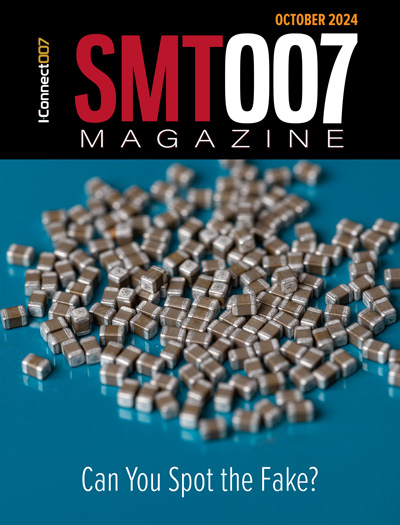-

- News
- Books
Featured Books
- smt007 Magazine
Latest Issues
Current Issue
Counterfeit Concerns
The distribution of counterfeit parts has become much more sophisticated in the past decade, and there's no reason to believe that trend is going to be stopping any time soon. What might crop up in the near future?

Solder Printing
In this issue, we turn a discerning eye to solder paste printing. As apertures shrink, and the requirement for multiple thicknesses of paste on the same board becomes more commonplace, consistently and accurately applying paste becomes ever more challenging.

A Culture of Thriving
One cannot simply command thriving; it must be nurtured, developed, and encouraged. In this issue, we explore strategies to improve your working relationship model—both internally and externally. In this culture of thriving, your business will grow in the process.
- Articles
- Columns
Search Console
- Links
- Media kit
||| MENU - smt007 Magazine
Predicting Brittle Fracture Failures
December 31, 1969 |Estimated reading time: 5 minutes
By Peter Borgesen and Bob Sykes
With expanded use of printed circuit board assemblies (PCBAs) containing lead-free BGA components, the challenge remains: how to predict and detect brittle fracture failures.
The integrity of solder joints has always been an issue with bumped devices such as BGAs and µBGAs; and continues to be a concern with the expanded use of lead-free solders. Studies indicate that lead-free solder joints can be particularly susceptible to brittle fracture failure at the ball-to-pad interface. These failures can occur over the entire life cycle of a product from manufacture through the end product.
Conventional shear testing is of little value when investigating or inspecting for brittle fracture failures. This is because most conventional shear tests fail in the bulk of the solder joint and not at the bond interface. Shear testing and pull testing at high speed produce more bond failures and more closely replicate high-strain-rate events. Although more research is required, there is growing evidence that when tested at high speeds, more bond failures occur with problematic interconnects. This, together with emerging high-speed force and energy measurement, may provide a suitable industrial tool for detecting brittle fracture.
 Figure 1. Typical solder shear figure.
Figure 1. Typical solder shear figure.
null
Ball Shear Failure Mechanisms
During conventional bondtesting, the solder ball is sheared off or pulled to destruction (Figure 1). This verifies that the bond is as strong as, or stronger than, the applied force, but does not measure the actual bond strength of the solder ball-to-pad interface. Conventional bondtesting has its place in screening for many manufacturing defects, but cannot detect the brittle fracture failure mode (Figure 2).
 Figure 2. Typical solder brittle fracture failure.
Figure 2. Typical solder brittle fracture failure.
Unlike certain fatigue failures, brittle fracture of BGA solder joints generally occurs during a major stress event, such as when an end product is dropped or undergoes a high-strain-rate flexure. Stress events can occur during board assembly, shipment and handling, or during end-product use. Studies indicate that brittle solder joint fractures may relate directly to the presence of voiding at the solder ball-to-pad interface due to certain plating and solder material combinations.1 The accepted industry method to assess solder joint integrity - solder ball shear testing - does not detect microstructural weaknesses consistently at the solder ball-to-pad interfaces associated with brittle fracture.
Testing at high-strain rates is not a new test method. Drop testing, for example, has been used for many years for this purpose. Drop testing will remain a useful and definitive test, and can be performed with a fully assembled end product and requires extensive setup and fixturing.
Much research has been conducted in the area of solder joint reliability and predicting failure modes of lead-free BGAs, including drop testing, three-to-four-point bendtesting, and microstructural analysis of the solder ball-to-pad interface. Various candidate methods of predicting the results of a drop test, including yield strength of ball pull and ball shear, as well as measuring impact strength, have been evaluated. The data derived from these tests have not established a direct correlation between shear strength or pull strength and voiding, or the detection of the brittle fracture failure mode.2,3
As a result, it was recognized that a test similar to conventional ball shear and pull testing was needed to quantify solder joint integrity relative to brittle fracture early in the manufacturing process. To achieve this, a consortium of device manufacturers, together with an equipment supplier, organized to develop a new bondtesting methodology and suitable equipment.
Bondtesting Methods
Conventional shear testing has been used for many years as a method to determine bond integrity. Shear testing is a good indicator of bond integrity; however, it cannot show more than the shear strength of the solder ball itself. A tensile test such as cold-bump pull is often used if the solder ball-to-pad interface requires further examination (Figure 3).
 Figure 3. Cold-bump pull bondtesting.
Figure 3. Cold-bump pull bondtesting.
Conventional bondtesting is limited to low speeds, typically in the range of millimeters per second. When bondtesting at lower speeds, the predominant failure mode tends to be solder shear. When this occurs, the test determines that the bond strength is greater than that of the sheared ball. This makes it virtually impossible to compare the effects that different pad finishes and solder alloys have on the solder ball-to-pad interface.
The speed of the shear test must be conducted at a higher rate, generally in the range of meters per second to test for resistance to brittle fracture. Testing at these higher speeds results in more bond failures and allows the performance of different pad finishes and solder alloys to be compared. A similar situation exists for pull testing solder balls, in which the test speed is high to achieve a transition to bond failures.
Bondtesting at high speeds increases the rate of strain on solder balls. This, in turn, transfers a higher force from the solder ball to the solder ball-to-pad bond, resulting in the bond being tested rather than the strength of the solder ball. Test results provide data about the bonding process, which is the information required to determine bond reliability. This type of testing allows the bond strength resulting from various pad finishes and solder alloy combinations to be measured and analyzed.
It has been noted that some voiding can be present in the Cu3Sn intermetallic immediately after reflow; and aging can contribute to the formation and growth of voids. These voids are often referred to as Kirkendall voids. They can form during an Au/Al wire-bonding process. However, in-depth studies suggest combinations of growth mechanisms involving a Kirkendall-type effect are more complex.
While this is a concern, it is more practical to be concerned with the mechanical robustness of the bond strength than with void percentages. Therefore, mechanical testing with a convenient, rapid-test method remains the optimum method to distinguish bond strength between different manufacturing lots of a given product.
Summary
Despite early success achieved with high-speed bondtesting, it is recognized that the industry has much to learn and this new technology will continue to evolve. Brittle fracture failures are a problem affecting many electronic products using lead-free BGA devices. Before the development of high-speed bondtesting, testing for solder joint integrity of lead-free BGA and µBGA devices has been a difficult, unreliable, and subjective process. Thus, a practical screening test capable of detecting weakened and potentially voided BGA solder joints early in the manufacturing process to closely approximate service conditions is desirable.
REFERENCES
- Keith Newman, Sun Microsystems, Inc., “BGA Brittle Fracture - Alternative Solder Joint Integrity Test Methods,” pp. 1194-1201, 2005 Electronic Components and Technology Conference.
- Tz-Cheng Chiu et. al., Texas Instruments, Inc., “Effect of Thermal Aging on Board Level Drop Reliability of Pb-Free BGA Packages,” pp. 1256-1262, 2004 Electronic Components and Technology Conference.
- M. Date et. al., UCLA and Hitachi Metals Ltd., “Impact Reliability of Solder Joints,” pp. 668-674, 2004 Electronic Components and Technology Conference.
PETER BORGESEN, manager of process research, Surface Mount Laboratory, Universal Instruments Corp., may be contacted at borgesen@uic.com. BOB SYKES, engineering manager, Dage Precision Industries, may be contacted at r.sykes@dage-group.com.


